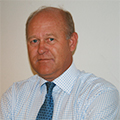Weda AB

About: Klas Lange - CEO
I have a Masters of Science in Mechanical Engineering from the Royal Institute of Technolgy in Stockholm. I first worked for four years with the Swedish Trade Commission in Toronto, Canada and thereafter for three years at the Weda subsidiary in Bridgeport´, CT, USA. Then back to Sweden to Manage Weda for a few years before taking a position as business area manager in a Swedish Industrial Group called Componenta AB, having Weda as one of the companies within the business area.. At first based in Holland and after about one year in Malmö Sweden after Componenta´s fusion with Svedala Industries AB. In 1991 I became a share holder in Weda AB and has since then been the CEO based at the Head Office in Södertälje, Sweden.
1. Weda under water cleaners commenced its journey as a solution for cleaning pools, what are the sectors you are serving and mention their applications?
Weda started as a foundry and later started production of submersible pumps for the construction and mining industries. In the mid 70´s Weda designed the first cleaners for public swimming pools. Initially, a hand-held unit based on the submersible pump. The first automatic cleaner was produced in 1981 and since then Weda has served most major markets with high-quality cleaners for public pools and adventure type pools.
In the early 1990´s Weda started a development project with Stockholm Water. The aim was to develop a cleaner for sediment removal in drinking water reservoirs and slow filters.
Today Weda has a range of cleaners for that purpose and for several other industrial applications. Just to mention a few:
• Sewage treatment plants
• Cooling Tower tanks
• Industrial reservoirs in- and outdoor
• Fishing industry tanks
• Nuclear power plants- reactor tanks and holding tanks
2. Designing robots for underwater cleaning is quite fascinating. What’s the level of accuracy and efficiency provided by your products?
Underwater robots with high capacity cleaning require strong pumps which mean that we still have to feed the power through cables. This complicates the development of fully robotic cleaners. Also, the design of many of the public pools and adventure type pools is making life difficult for us. We would like to come into newly developed pools, tanks, and reservoirs at an early level so that we can give input from our perspective in regards to solutions for fully automatic cleaners.
Today all cleaners are PLC controlled with programming options since many pool facilities have more than one pool.
In many applications today our cleaners are able to clean a larger area in fully automatic mode and may require a finishing cleaning by radio remote controls.
3. WEDA has acquired an official assignment earlier namely the Olympics in Athens 2004.Are you looking forward to work for the Summer Olympics 2020?
We have no plans for the Olympics in Tokyo since Japan is not a market for us at the moment.
4. What are the main purposes of these cleaning Robots in the industry sector? How and who are benefited?
There are several purposes with the use of the Weda machines.
• By using underwater cleaners the tanks/reservoirs do not need to be drained. The benefits of this are several:
- Less water wasted, this is becoming more and more important by the day
- No structural damages when concrete reservoirs are emptied there is a big risk for cracking
- Clean reservoirs require fewer chemicals added to the water
- Tanks can be cleaned without human entry. Minimizes the risk for health problems especially in reservoirs in cooling towers where there is a big risk for legionella
- Less expensive normally than using divers.
5. As a CEO, what would you say is the biggest challenge faced by your firm in terms of growth and designing new products keeping in mind the industrial requirements?
We are the first and sometimes only company the offers underwater cleaning in many of the applications mentioned above. This means that the cleaning has been handled in different ways in earlier days and it has taken us a long time to convince clients to change methods for cleaning.
We aim to further develop products for new applications and preferably we would like to do this in cooperation with companies that already are active in the specific application. One example of this is cooperation with Westinghouse for the development of the so-called U-DEC. This is a robot for cleaning of bottoms and walls in reactor tanks in nuclear power stations.

